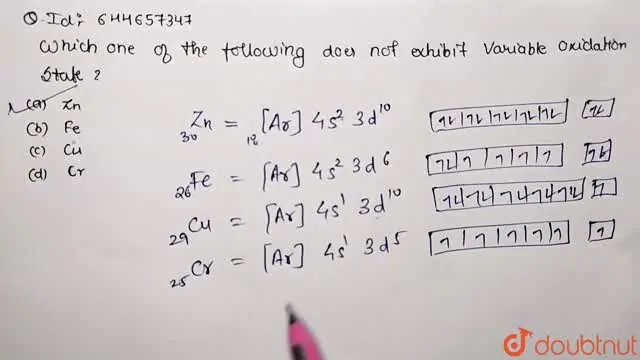Which one of the following does not exhibit variable oxidation states?
Zn
Fe
Cu
Cr
The correct Answer is:A
Step by step video & image solution for Which one of the following does not exhibit variable oxidation states? by Chemistry experts to help you in doubts & scoring excellent marks in Class 12 exams.
Related Playlists
- BOOK - VMC MODULES ENGLISHCHAPTER - PERIODIC PROPERTIES OF ELEMENTSEXERCISE - EFFICIENT50videos
PERIODIC PROPERTIES OF ELEMENTS
- BOOK - VMC MODULES ENGLISHCHAPTER - p-BLOCK ELEMENTS-1EXERCISE - JEE Advanced Archive48videos
p-BLOCK ELEMENTS-1
- BOOK - VMC MODULES ENGLISHCHAPTER - QUIZEXERCISE - CHEMISTRY30videos
QUIZ
Similar Questions
Which one of the following elements does exhibit +1 oxidation state as well ?
AI, B, Ca, TI, Be.View SolutionWhich of the following element does not show the variable oxidation state ?
View SolutionWhich of the following element does not show the variable oxidation state ?
View SolutionWhich transition element does not exhibit variable oxidation state?
View SolutionWhy fluorine does not exhibit any positive oxidation state?
View SolutionWhich of the following metals exhibits more than one oxidation state ?
View SolutionWhich one of the following complexes does not exhibit chirality?
View SolutionWhich of the following element exhibits maximum oxidation state
View SolutionWhich one of the following does not exhibit the phenomenon of mutarotation ?
View SolutionWhich one of the following, exhibits highest oxidation state
View Solution


